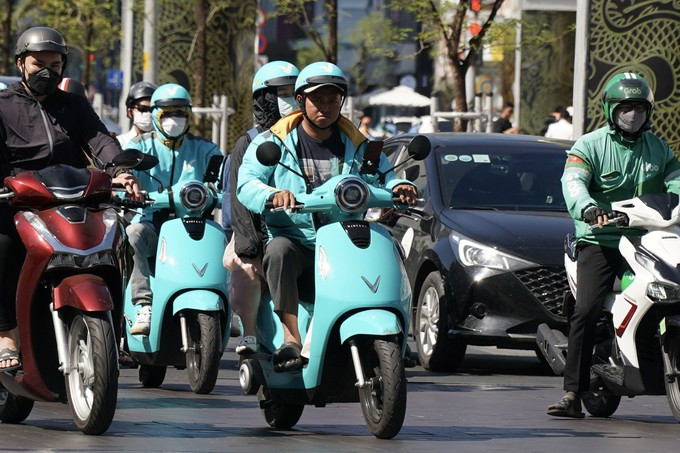
Lorries, buses and coaches are responsible for great emissions from road transport in the country. According to forecasts of the Institute of Transport Development and Strategy, Vietnam will achieve emissions of about 64.3 million tons of Carbon dioxide (CO2) in 2025 and 88.1 million tons of CO2 in 2030. Of which, heavy-duty vehicles – trucks and buses - especially in large cities such as Ho Chi Minh City and Hanoi, are responsible for releasing the highest emissions accounting for about 80 percent of the emissions.
Therefore, the Government and the Ministry of Transport are very interested in promoting solutions to reduce CO2 emissions in road transportation by converting vehicles using internal combustion engines to electric vehicles and other types of vehicles using green energy.
Hanoi is currently one of the leading localities in green energy conversion in the transportation industry when there are many types of environmentally friendly public transport being exploited in the country, including buses using clean fuel CNG and electric buses, electric taxis, rail, two-wheeled electric vehicles and public bicycles.
Of the total 2,000 fleets of buses, Hanoi has 277 electric vehicles and vehicles using clean CNG fuel, accounting for 13.6 percent of the total number of vehicles. A representative of the Hanoi Department of Transport said that the roadmap to converting public passenger transport vehicles to green energy will be implemented in 2 phases. In the first from 2025-2030, 157 vehicles will be converted yearly and in the second phase from 2031-2035, 162 vehicles will be converted a year.
Meanwhile, Ho Chi Minh City has targeted 100 percent of taxis will be replaced and invested in using electricity and green energy from 2030. By 2050, all buses and taxis will use electricity and green energy. Deputy Minister of Transport Le Anh Tuan said that up to this point, many businesses in Vietnam have promoted the green transformation process by promoting domestic electric vehicle production and building charging station infrastructure nationwide; simultaneously, new standards in environmental - social - corporate governance activities have been set up.
For the implementation of the Prime Minister’s Decision 876/QD-TTg on the Action Program on green energy conversion and reducing carbon and methane emissions of the transport sector, the Ministry of Transport has proposed a series of policies including incentives for those who converted the vehicles into electric vehicles.

However, the green transformation is still facing many challenges such as a lack of infrastructure and charging stations, the cost of electric vehicles is still high in addition to lack of mechanisms to encourage the consumption and use of electric cars and improper awareness of agencies and businesses about green energy conversion.
While roads are having positive results in green transformation, the remaining sectors are still quite lagging behind.
As the second largest factor after roads, water transport services are responsible for 10 percent of the transport sector's total CO2 emissions. Currently, these transportation services are still using mainly fossil fuels. Mr. Bui Thien Thu, Director of the Inland Waterways Department, said that green transformation in the waterway sector is very difficult and requires large funds because the ships and boats are old and outdated.
To achieve the goal of reducing emissions throughout the transportation sector, the waterway sector also has plans to replace new generation vehicles, such as using push-pull barges, self-propelled barges with large tonnage boats, and specialized boats. Using containers and new generation vehicles with hybrid and electric engines. In addition, businesses will convert and repair ships and boats that use gasoline and oil to use clean fuel LNG, solar energy, and wind energy.
However, ministries and agencies need to have policies to encourage new construction facilities and the use of new generation vehicles for the successful implementation of the plan. In the aviation sector, according to scientists' calculations, flights release an average of 1 billion tons of carbon per year, accounting for about 3 percent of global emissions.
Recently, countries agreed to reduce carbon emissions in the aviation industry by 5 percent by 2030. Agreeing with this goal, Ms. Vu Thi Thanh, Deputy Head of the Department of Science, Technology and Environment said that Vietnam has submitted a National Action Plan report on reducing CO2 emissions in civil aviation activities in Vietnam. The plan was made based on considerations of the domestic aviation market, the operation of new airlines and new air routes.
The basic solutions to reduce CO2 emissions into the atmosphere that are being implemented are investing in innovation and modernization of the aircraft fleet, and modifying international flight routes to shorten flight times.
Currently, the national airline Vietnam Airlines is applying single-engine taxiing (SET) solutions involving the use of only half the number of engines installed to generate the energy needed for taxiing to reduce noise at the airport and reduce fuel consumption. The solutions are expected to help reduce emissions.
As a result, after 5 years of applying this solution, Vietnam Airlines has reduced more than 4,000 tons of CO2. However, these are just the beginning steps.
Source: SGGP